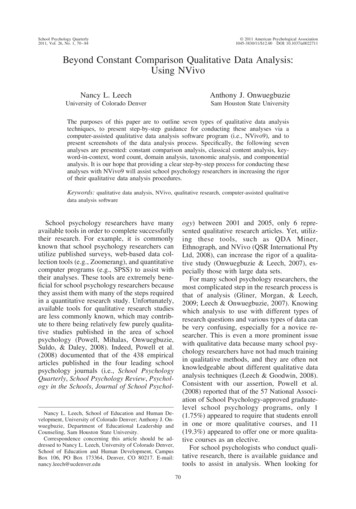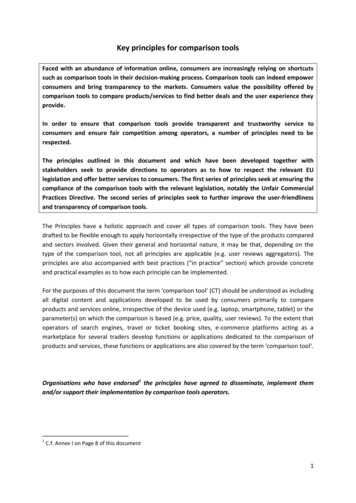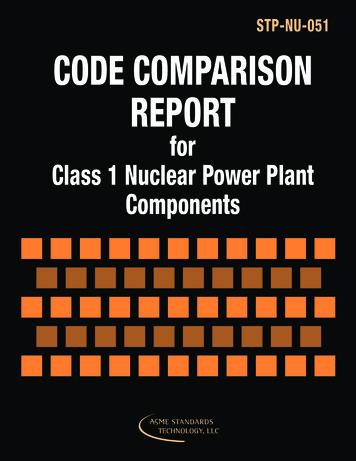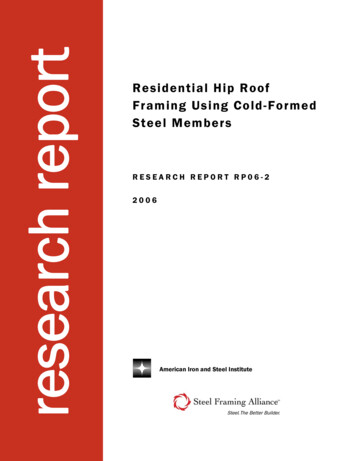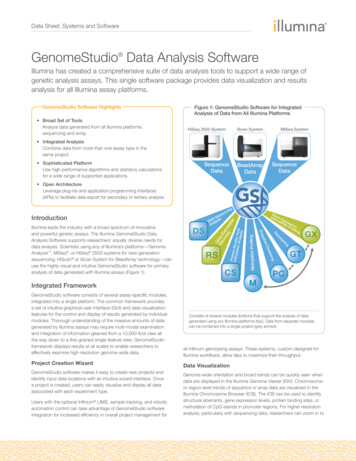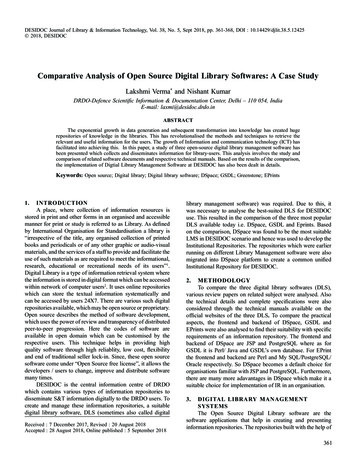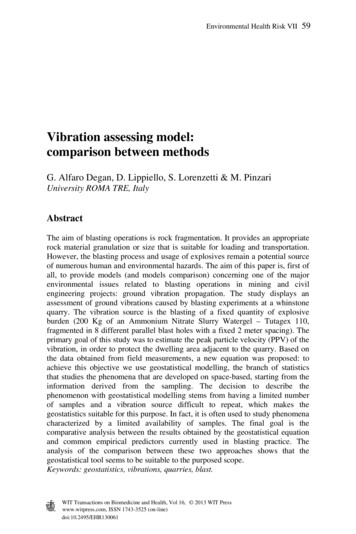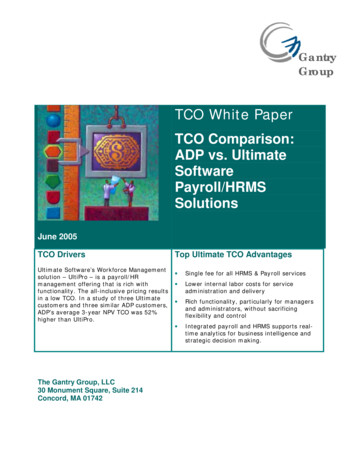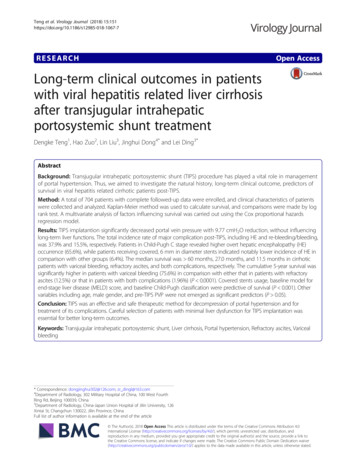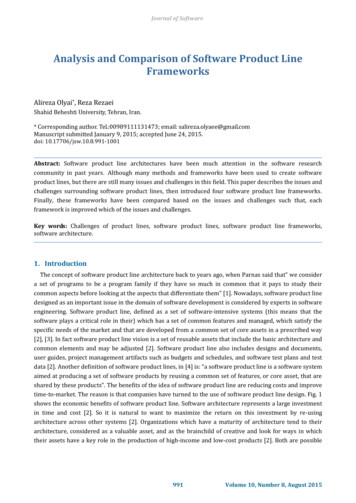
Transcription
Journal of SoftwareAnalysis and Comparison of Software Product LineFrameworksAlireza Olyai*, Reza RezaeiShahid Beheshti University, Tehran, Iran.* Corresponding author. Tel.:00989111131473; email: salireza.olyaee@gmail.comManuscript submitted January 9, 2015; accepted June 24, 2015.doi: 10.17706/jsw.10.8.991-1001Abstract: Software product line architectures have been much attention in the software researchcommunity in past years. Although many methods and frameworks have been used to create softwareproduct lines, but there are still many issues and challenges in this field. This paper describes the issues andchallenges surrounding software product lines, then introduced four software product line frameworks.Finally, these frameworks have been compared based on the issues and challenges such that, eachframework is improved which of the issues and challenges.Key words: Challenges of product lines, software product lines, software product line frameworks,software architecture.1. IntroductionThe concept of software product line architecture back to years ago, when Parnas said that” we considera set of programs to be a program family if they have so much in common that it pays to study theircommon aspects before looking at the aspects that differentiate them” [1]. Nowadays, software product linedesigned as an important issue in the domain of software development is considered by experts in softwareengineering. Software product line, defined as a set of software-intensive systems (this means that thesoftware plays a critical role in their) which has a set of common features and managed, which satisfy thespecific needs of the market and that are developed from a common set of core assets in a prescribed way[2], [3]. In fact software product line vision is a set of reusable assets that include the basic architecture andcommon elements and may be adjusted [2]. Software product line also includes designs and documents,user guides, project management artifacts such as budgets and schedules, and software test plans and testdata [2]. Another definition of software product lines, in [4] is: “a software product line is a software systemaimed at producing a set of software products by reusing a common set of features, or core asset, that areshared by these products”. The benefits of the idea of software product line are reducing costs and improvetime-to-market. The reason is that companies have turned to the use of software product line design. Fig. 1shows the economic benefits of software product line. Software architecture represents a large investmentin time and cost [2]. So it is natural to want to maximize the return on this investment by re-usingarchitecture across other systems [2]. Organizations which have a maturity of architecture tend to theirarchitecture, considered as a valuable asset, and as the brainchild of creative and look for ways in whichtheir assets have a key role in the production of high-income and low-cost products [2]. Both are possible991Volume 10, Number 8, August 2015
Journal of Softwarewith architecture re-use. When an organization is producing similar systems and using the samearchitecture, the organization obtains a large gain that includes the reduced cost of construction andreduced time to market [2]. Generally, the development of product line requirements an architecturalapproach in which the core architecture capture both the commonalities shared by all the products and thevariability of individual products the so–called variation points [2], [5]. So, we can say a software productline consists of a family of software systems that have some common functionality and some variablefunctionality [6].Fig. 1. Economics of software product line engineering similar to [7].The reuse of software artifacts is a key factor in software product line, so it is important to buildenvironments that support such practice, as well as a strong architecture related to it [8].Improvingvariability in a system implies making it easier to do certain kinds of changes [9].In variability a variationpoint represents a delayed design decision [10]. Managing the differences between products is a keysuccess factor in software product families [11]. To design software product line architecture is proposedvarious methods or frameworks, but still these frameworks have not resolved all the issues and challengesassociated with software product lines. Some of basic frameworks for software product line that have theirroots in other frameworks could be COPA or component-oriented platform architecting is a softwareproduct line framework that is component-oriented. The goal of the COPA framework is the alignmentbetween business, architecture, process and organization [12]. FAST or Family-Oriented Abstraction,Specification and Translation is a software development process is focused on the construction of productfamilies [12]. In FAST framework divides the process of a product line into three sections, including thedomain qualification, domain engineering and application engineering [13]. FORM or feature-orientedreuse method is a feature oriented method that, by analyzing the features of the domain, and use thesefeatures provide the software product line architecture .In other words, “FORM is a systematic method thatfocuses on capturing commonalities and differences of applications in a domain in terms of “features” andusing the analysis results to develop domain architectures and components” [14]. Kobra is acomponent-oriented approach to develop a product line based on the UML features. This methodintegrated the two paradigms into a semantic, unified approach to software development and maintenance[15]. This method can be used to support the Model Driven Architecture [12]. QADA or Quality-drivenArchitecture Design and Analysis, is a product line architecture design method that provides traceabilitybetween the product quality and design time quality assessment [12]. In fact, QADA method includesarchitectural design and quality analysis [16]. In this study the issues and challenges of designing asoftware product line is presented in terms of administrative and organizational aspects and technicalaspects also described four software product line frameworks. Then, these frameworks are compared with992Volume 10, Number 8, August 2015
Journal of Softwareeach other based on issues and challenges raised such that, each framework is improved which of the issuesand challenges.2. Issues and Challenges in Software Product Line DevelopmentProduct line architectures challenges which are not present single product architectures [17], and thismade them different from the single product architecture. Issues and challenges in developing a softwareproduct line in [18] are evaluated from two aspects.2.1. Administrative and Organization AspectsFor the develop software product line some organization factors should be examined and the resultsanalyzed to obtain organizational success. Organizational factors and their impact on software product linecan be categorized as follows: Roles and responsibilities within an organizational structure: Roles and responsibilities must bedefined and classified to conform to the product line and end–product development processes.Successful software product line engineering requires management and coordination of the reusablecomponents and end–product development projects to obtain the business objectives of theorganization. Also the organizational structure should be compatible with the new roles andresponsibilities. Changes in organization structure may cause resistance to change and reduce themotivation for their employees in the organization. Developing a software product line has a lot ofproblems due to its inherent complexity. Reusable components should be designed and developed bythe domain engineering; also, these reusable components should be designed and integrated in theend-product by the application engineers. Intergroup communication capabilities: Mechanisms of interaction should be defined for anintergroup communication establishment. Interaction mechanisms should be defined in thedevelopment life cycle. “Since the development life cycles of the product line and the end–productdevelopment are strongly related to each other, a well–established inter-group communication willhave a bigger contribution on the success of product lines than it would have in single productdevelopment projects”[18]. Changing thinking and continuous learning of the concept of software product line: Product Lineconcepts should be introduced to staff up the specific features of the product line to be considered atall stages of the development life cycle. Changes required for improvement of the organizationalculture should be considered. Training: Personnel should be trained on all aspects of the product line, such as architecture,processes and methodologies. Regularly so that training programs should be done to increaseorganizational knowledge. Adapting new technologies in the product line: Development of current and future productsplanned in the near future should be aligned with the advancement of technology. Continuousimprovements are needed to accommodate new technologies in the product line, to maintaincompetitive in related products. Strategic plans of the organization: Higher level of monitoring and tracking are needed to determinea new strategic direction for the introduction of new product families in the market. Product linedevelopment strategy should be added to organization‘s functional areas of business and long termorganizational objective. Strategic planning should be clearly outline what is to be developed from thesoftware product line in order to gain competitive advantages and capture market segments to achievestrategic targets.993Volume 10, Number 8, August 2015
Journal of Software Marketing strategies: Marketing Strategies should be developed for favorite product with the mostappropriate timing for the not to miss market opportunities. Generally, product lines serve to a specificdomain. For obtaining a competitive advantage in the market, and satisfy the needs of this domain, biginitial investment might be required. Takes a long time for developing a mature product line; whichmeans that the revenues might not be realizable in near or even mid-terms in some cases. Hence, thetime required to deliver the product to market is very important. So, software product linedevelopment, in the long term, can be a more economical choice. However, developing reusable coreartifacts could not be amortized, if only a few products with little commonality will be produced.2.2. Technical AspectsIn this section we will try to discuss the challenges in the development of the product line. A keydifference between traditional reuse and ideas of the product line is variability, which means that thereusable assets of a product line should be designed explicitly to obtain differences. Variability has impacton all artifacts, from requirements to code. Requirements: In requirements, types of variability can exist in product line includes: a requirementmay be mandatory or optional for all or some of the end-products, a requirement might depend onother requirements, a requirement may be incompatible with other requirements, and a requirementmay have variations in details. Each item listed in the specific context of practical difficulties, andrequirements analysis techniques used in traditional development cannot be implemented in all thesevariations. There is no systematic process for identifying and managing conflicts of requirements inthe case that the requirements are written in natural language. Formal specification languages thatwere provided for this purpose are very complex and difficult for non-experts. Design: It is important to architecture design to be less dependency between modules to be too muchtrouble during the development and maintenance. This main factor is difficult to achieve, especially forcases of product line migration. Another design problem encountered in practice is the so-calleddesign erosion. Means that the initial development that is not enough to consider all aspects of designand various external factors such as timing Pressure and intolerances of management to product linecost and time overhead, etc. Design erosion, integration and maintenance costs will increase and willbe working again. Another important problem, more complex software systems must be developed bya multi-tier architecture that can often be implemented in future product line. Currently, not muchdata about multi layer product lines compositions. Implementation: For the programming stage of the development phase, if a lot of code complexitymetrics seem to be also applicable to product lines at first glance, some of which may be misleading tomonitoring the progress. Therefore, other metrics such as evaluation rate, dependencies betweenmodules based on complexity, etc. should be defined and used. There are not many research studiesabout the use and importance of existing metrics in product lines or definition of new product linespecific metrics. Test: Due to the variability of requirements, verification is generally more complex than a singleproduct. For unit testing, test cases must be carefully selected and the logical way in order to minimizethe time to testing and to avoid the error of error detection. Integration Testing due to the variabilityand dependencies between different products is more challenging. It should be designed carefully andoften as an iterative integrated activity. Moreover, regression testing, which is often a confusing topiceven for a single product development, becomes more complex in the product lines. Maintenance: High level of reuse in product line causes increasing challenges in the maintenance. Aslong as a product line evolves, reuse traceability is weak due to activities such as bug fixing,994Volume 10, Number 8, August 2015
Journal of Softwarefunctionality addition, performance optimization, etc. Another important problem is that maintenanceactivities are typically based code. Since the code-centric approach to avoid seeing the full picture ofthe inter- and intra-module dependencies, Special care should be given in order to spread the impactsof maintenance activities of all related products, appropriately. The ideal way to obtain such spread iscross–product line review for all change requests. So this is impractical and requires the participationof a large number of personnel from different teams; and hence, such studies need to spend time andcost.3. Overview of Software Product Line FrameworksFramework 1: DRAMADRAMA is a framework for domain requirements analysis and modeling architectures in softwareproduct lines. The goal is to provide a framework for modeling domain architecture based on the domainrequirements within product lines. This study focused on the relationship between requirements andarchitectural structures. This framework includes processes, methods and a supporting tool [19]. Theframework uses the four concepts, includes, goal-oriented domain requirements analysis, AnalyticalHierarchy Process, Matrix technique, and architecture styles [19]. This framework is shown, in Fig. 2similar to [19]. The DRAMA framework, in [19] is presented as follows:1) Identifying components that make up the architecture, is obtained of the requirement analysis. Goalmodeling used to elicit and to identify components according to four abstraction levels of requirements:business level, service level, interaction level, and internal level. At the end of this phase, thecomponents are constructed.2) Calculating the priority of components: the priority of components is calculated through AHP (Analytic HierarchyProcess) to understand which components have a major role.3) Calculating the priority of quality attributes: the matrix technique is used to obtain the priority of eachquality attribute. (the matrix technique is to identify the relationship between six quality attributes andcomponents and to calculate how each component corresponds to the six quality attribute)4) Modeling domain architectures: an architecture structure is obtained based on quality attributes.Domain architectures are built through components and quality attributes using architecture styles.Fig. 2. Architecture of framework.995Volume 10, Number 8, August 2015
Journal of SoftwareFramework 2This framework is an architecture-based method for selecting composer components to make a softwareproduct line. This method can manage and control the complexities of the component selection problem inthe creation of declared the product line [20]. With this method a product line will be constructed withaccepted good components to cover up requirements based on the architecture [20]. That's why softwareproduct line development process reduces risks and costs of development. The method constructed in thisframework is based on component oriented design. The framework built in architectural platform for theselection of a component with respect to different aspects related to reference architecture, product linerequirement, domain requirement and priorities of the stakeholders [20]. Architecture of Method in [20] isas follows:1) In Fig. 3, similar to [20], the idea of the method in selecting of the components is presented. The methodsurrounded by reference architecture because the reference architecture has a high impact on theselection of the components. Reference architecture defines requirements for components on theproduct line and limiting them to follow the rules. In the beginning step, a components list should beselected from component lists with respect to the architecture variant point. The components of the list canbe selected from COTS components (COTS components are on the shelf that are produced by ourorganization or other entities.) or previously–produced components or be produced specially for theproduct line.Fig. 3. Architecture of method.2) In the next step, selected components will be evaluated through a feature list such as cost, time to marketand quality attributes. This information is used for component selecting in the selection step. Also, theneed is to respect the reference architecture in selection step. In this step, some of the information isextracted from domain requirements and some from priorities repository. Domain requirementsconcern about special domain requirements and priority repository concerns about the organizationpriorities. If the component is approved, method will go to integrity test step.3) In the integrity test step, selected components are checked together; these components are stored in theKB. This means, a new component is checked against KB that they do not have a conflict in requirements.The feedback from this step goes to the selection step in cases which the selected component is removedfrom integrity test and there is a need for the newly selected component.996Volume 10, Number 8, August 2015
Journal of Software4) In the evaluation step, the architecture will be evaluated according to the selected components. In thisstep, it is possible to change the architecture to adapt to the requirements of the selected components andincrease product quality and reduce cost. Also, the removed components are considered and architectureis evaluated. The feedback from this step goes to the selection step.There is a two-way relationship between evaluation step and reference architecture; because, there maybe errors in design of the architecture. After evaluation step, the method returns to the first step and selectsa new component. Selection process continues until selection of the all components.Framework 3In this framework security mechanisms served to the domain requirements and applicationrequirements of software product line. In fact the product line has been enriched. This framework in [21] ispresented as follows:Fig. 4. Framework for software product line.This framework includes two types of activities : application engineering (at the top of the figure) anddomain engineering (at the bottom of the figure). This framework is shown, in Fig. 4 similar to [21]. Theintegration of the product line security domain requirements engineering (PLSecDomReq) and product linesecurity application requirements engineering (PLSecAppReq) SREPPLine activates within activates ofdomain engineering and application engineering is shown in the figure with a dotted line. SREPPLineactivities should be integrated in the domain analysis activities and application engineering processes in anorganization where the software development idea is based on the software product line engineering. Inthe center of the figure is an arrow indicating the direction of SREPPLINE is the same path product lineengineering that should be integrated into software product line engineering. It is not designed forintegration into a reverse engineering process. Repositories, traceability, and implementation of the997Volume 10, Number 8, August 2015
Journal of Softwaresecurity reference model as shown in the center of figure. The link between the software product linerepositories and the repositories of its derived from applications are also shown. The repositories are:1) Software product line repository: It keeps the common artifacts of the product line and the links with theartifacts of their derived applications.2) Application repository : There is a repository for all application types that are derived from the productline. This repository registers the artifacts derived from the product line and the application’s Specificartifacts3) Software product line Security Assets repository : This manages the product line security artifacts such as securityobjectives, threats, security requirements, etc. and the relations with the security artifacts of their derivedapplication ,the security standards and Related artifacts of the product line such as, accessibility requirements.4) Application Security Asset repository: This repository manages security artifacts derived from theproduct line and the specific security artifacts of the application. It also manages the links with therelated artifacts of the application and the security standards.5) The security standards repository registers the security standards such as ISO/IEC 27001 controls or ISO /IEC 15408 components.Framework 4This framework is for software product line engineering comprises the concepts of the traditionalproduct line engineering, namely the use of the platform and the ability to provide mass customization [22].The idea of software product line engineering is composed of two separate processes. The idea of theframework is shown, in Fig. 5 similar to [22]. This framework in [22] is presented as follows:1) Domain engineering: This process is responsible for creating reusable platforms, thereby defining thecommonality and the variability of product line software. The platform includes all software artifactssuch as requirements, design, realization, tests, etc.Traceability links between these products facilitate consistent and systematic reuse. Domain engineeringprocess, a combination of five key sub-processes, including product management, domain requirementsengineering, domain design, domain realization, domain testing.2) Application engineering: This process is responsible for mining product line applications from theplatform created in domain engineering. This process is a combination of the sub-processes applicationrequirements engineering, application design, application realization, application testing.Fig. 5. The software product line engineering framework.998Volume 10, Number 8, August 2015
Journal of Software4. DiscussionThis section has compared four frameworks for software product line and checks each frameworkimproves which of the issues and challenges of software product line. Each of the frameworks underevaluation has a specific purpose and some of the challenges of product line covered. The overall goal ofthese frameworks is the produce architecture of software product lines.DRAMA framework is built based on the FORM framework. One of the technical challenges of softwareproduct line is about requirements. With regard to questions such as: “How can we analyze domainrequirements for modeling domain architecture? How can we design domain architecture corresponding todomain requirements? How can we assure that domain architecture can be reconfigured according tochanging requirements?”[19] The answer to these questions is the use of traceability between domainrequirements and domain architecture [19]. Much research in this area has been done and provided themany frameworks for the areas that could not support the challenge even FORM framework is afeature-oriented reuse method can not to support relationships between requirements and architecture.DRAMA is a framework that improves the requirements challenge because one of the main goals of thisframework is the traceability between requirements and domain architecture. This means that changes inusers’ needs are reflected in the architecture. Thus, this framework can be useful to obtain bettertime-to-market. From this viewpoint can in the organizational and administrative aspects the improveissues of organization strategic plans and marketing strategies. Validation of the framework is performedwith a home integrated system product line.Table 1. Frameworks Influence on Issues and ChallengeFrameworksIssues and ChallengesStrategicplansorganizationofMarketing k2Framework3Framework4 Security requirements Design ImplementationTest MaintenanceFramework 2 was developed based on the basic framework of COPA. This framework according to thecharacteristics of COPA, a component-oriented software product line development. This framework aim iscontrol and manages the complexities of the component selection problem in the product line. According tothe characteristics of component reuse and a list of features that are considered in the framework forselecting the components included reducing the cost and time-to-market, this framework can reduce thecost and time-to-market in software product line. So from this point of view can improve the issues oforganization strategic plans and marketing strategies. Also the use of components reduces the dependencybetween them; hence this framework improves the challenges related to the design. On the other hand, ifmade a high level of reuse of components increases the challenge of Maintenance in the product line.999Volume 10, Number 8, August 2015
Journal of SoftwareValidation of the framework is illustrated with electronics industry product line like TV.Framework 3 is built on a base FAST framework. Its main goal is to provide the security qualityrequirements in software product line. If requirements be considered as one of the technical challenges ofproduct line, providing security requirements specification for product line can be more challenging for theproduct line hence, this framework has improved the challenge. The framework was validated by a casestudy in the field of electronic billing.Framework 4 is built on a base FAST framework. This framework provides a platform to facilitate masscustomization to meet the needs of various stakeholders. For this purpose, the concept of variability isintroduced in the platform. This platform is a powerful platform for creating customer applications in ashort time. In this framework, based on input from Product Management, domain requirementsengineering predicts future changes in requirements, such as regulations, standards, and changes intechnology and market requirements for future applications. Hence, this framework can be improvedchallenge of the requirements. It can also improve the issues of organization strategic plans and marketingstrategies. Also the result of the domain realization is consists of loosely coupled, configurable components.It can improve the design challenges in terms of reducing the dependencies between components.According to the discussion section of the paper, Table 1 presents the influence of frameworks on the issuesand challenges for software production line.5. ConclusionBy combining the application of these frameworks, the key results are as follow.One of the main goals of the architecture of software product lines and the four frameworks is to reducecosts and time-to-market. Hence, these frameworks can improve the issues of organization strategic plansand marketing strategies. DRAMA framework, can establish traceability between requirements andarchitecture and framework 4 with a strong platform to meet the needs of various stakeholders canimprove the challenges related to requirements. Framework 3 can enrich the product line and improve thechallenges of security requirements in the product line. Framework 2 and framework 4, can improve thedesign challenge, to reduce the dependencies between software components. In framework 2, high-levelreuse of components may give rise to challenges relating to Maintenance.6. References[1][2][3][4][5][6][7][8][9]Parnas, D. L. (1976). On the design and development of program families. Software Engineering, 1-9.Bass, L., Clements, P., & Kazman, R. (2003). Software Architecture in Practice. Addision Wesley.Northrop, L. M. (2002). SEI's software product line tenets. IEEE Software, 19(4), 32-40.Anquetil, N., Kulesza, U., Mitschke, R., Moreira, A., Royer, J. C., Rummler, A., et al., (2010). Amodel-driven traceability framework for software product lines. Software & Systems Modeling, 9(4),427-451.Clements, P., & Northrop, L. (2002). Software Product Lines. Addison-Wesley.Gomaa, H. (2006). Designing software product lines with uml 2.0: From use cases to pattern-basedsoftware architectures. Proceedings of Conference on 2006 10th International the So
data [2]. Another definition of software product lines, in [4] is: a software product line is a software system aimed at producing a set of software products by reusing a common set of features, or core asset, that are shared by these products. The benefits of the idea of software product line are reducing costs and improve time-to-market.

